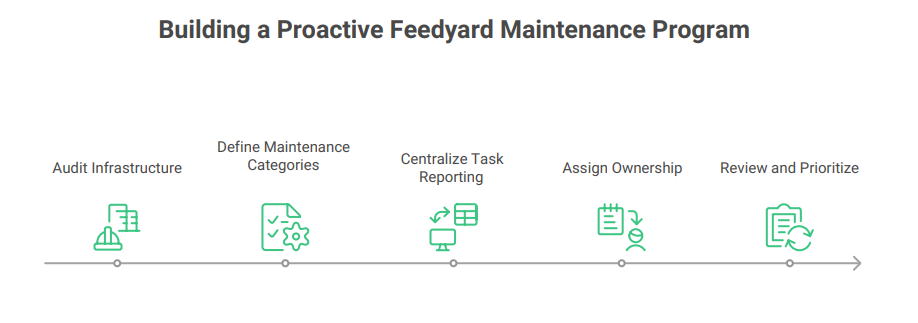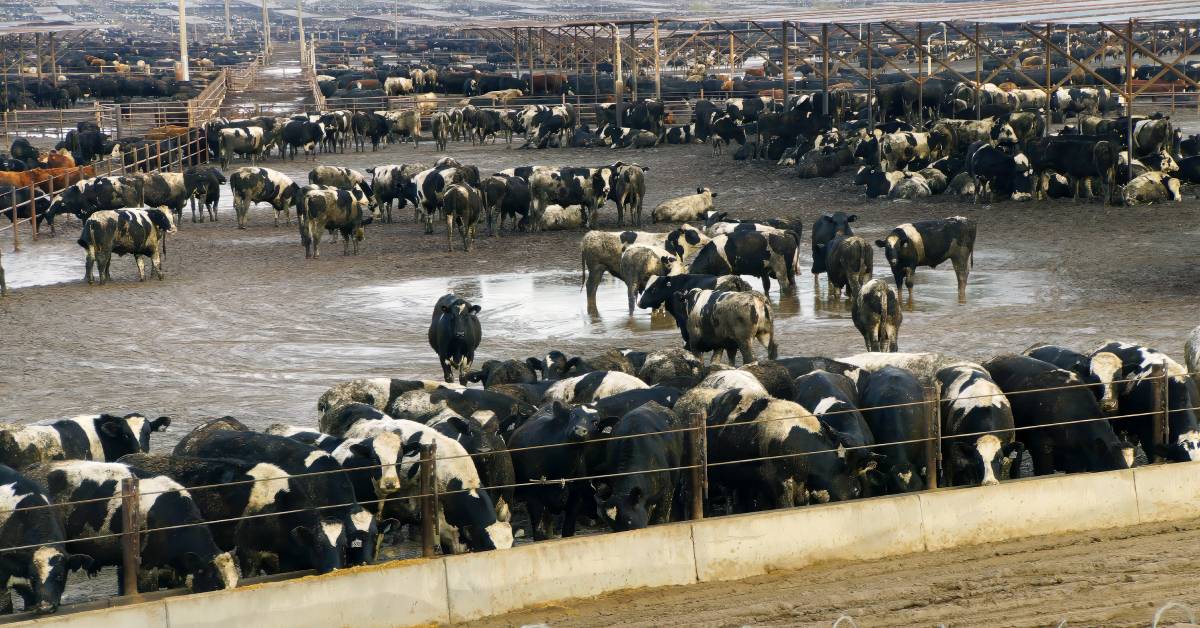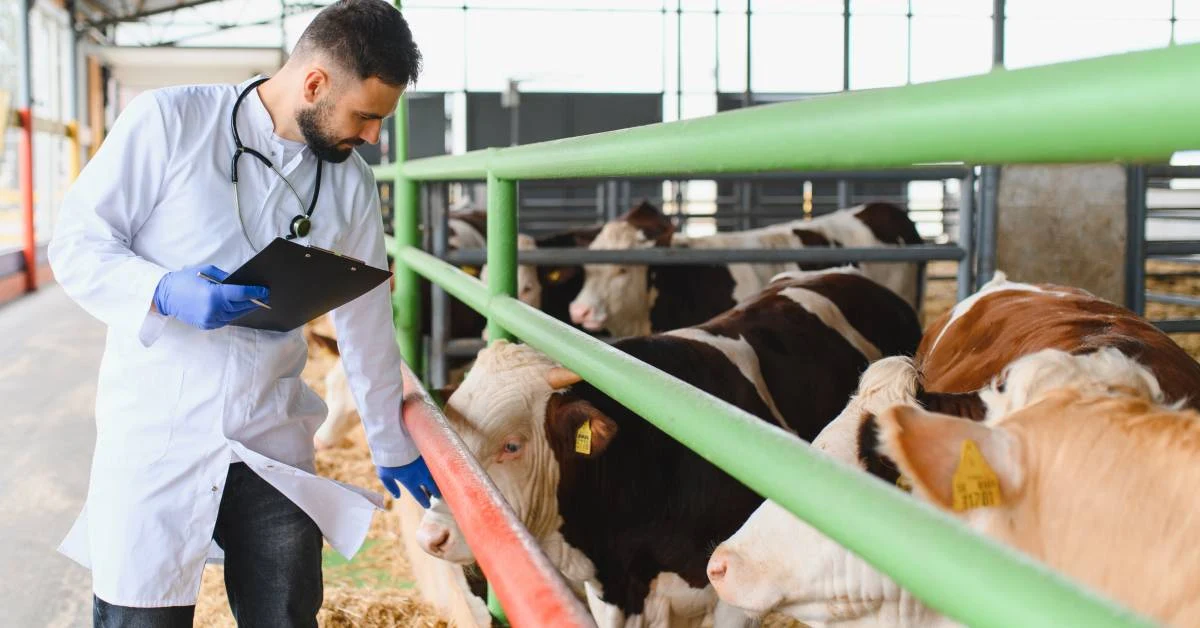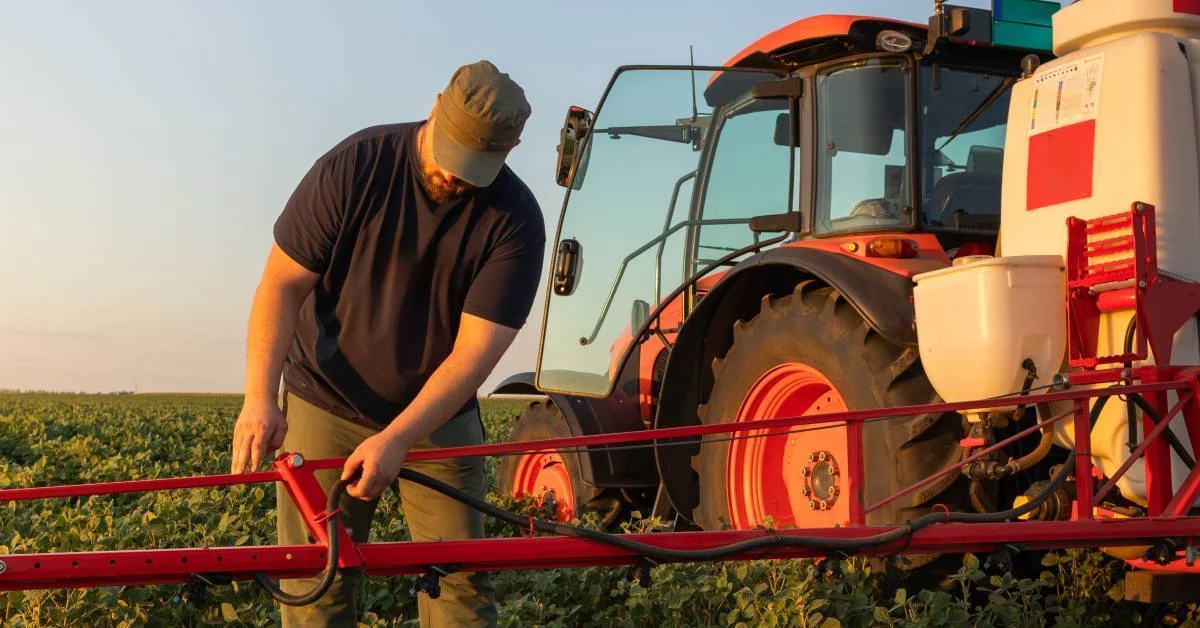Cattle performance rarely declines without cause, and feedyard managers know it’s not always the ration or health protocols at fault. More often, the problem starts at ground level, due to poorly drained pens, malfunctioning waterers, uneven surfaces, or infrastructure that hasn’t been inspected in weeks. These lapses in feedyard maintenance don’t just affect cattle comfort; they compromise intakes, reduce ADG, spike treatment rates, and disrupt overall pen performance.
Yet for all its impact, feedyard maintenance remains one of the most inconsistently managed areas in most operations. Not due to lack of awareness, but because reactive work orders, paper-based scheduling, and chronic labor gaps keep even the best yards behind the curve. In this blog, we’ll break down where maintenance failures hit hardest and how digital feedlot maintenance tools can help you avoid costly downtime and keep your cattle performing at their best.
Critical Areas Where Maintenance Affects Cattle Health and Output
Maintenance issues don’t always show up where operators expect. In many yards, the most performance-limiting problems aren’t broken equipment. They’re persistent, low-grade conditions like compacted mounds that never dry out, chronically slow-draining pens, or waterers that deliver just under optimal flow. These issues don’t trigger alarms, but they quietly disrupt feed intake, lying behavior, and thermoregulation.
Let’s break down the areas that matter most in feedyard maintenance:
1. Pen Drainage & Surface Maintenance
Pen conditions quietly dictate performance, more than many yards realize. Even when feed, water, and cattle health protocols are on point, poor drainage undermines everything. Sloppy footing increases energy use, reduces lying time, and triggers foot health issues that go unnoticed until gains drop.
What top yards get right:
- 3–5% slope from bunk to backline ensures steady runoff. Anything less causes pooling underfoot.
- Clay or lime-packed mounds shed water and hold their shape far better than manure-based builds.
- 4–8 inches of mud can drop ADG by 5–15% and push the cost of gain up by 50%+.
- Weekly micro-grading around high-traffic zones keeps pens dry and uniform.
- Fly ash or packed gravel improves drying time in tight-pen operations.
- 25–35% surface moisture gives you crust without dust, which is vital for heat-stressed cattle.
2. Waterer & Trough Maintenance
Even small inefficiencies at your water points silently affect performance. When flow rates dip below optimal levels or water quality degrades, cattle reduce intake, become more heat-sensitive, and eventually slow gains. Fixing troughs in feedyard maintenance isn’t just a chore; it’s a direct investment in DMI, ADG, and herd resilience.
What high-performing yards manage well:
- Ensure each trough delivers at least 8–10 gallons per minute per 100 head, especially vital during heat stress periods, when cattle may need 1.1 % of body weight per hour (≈ 1.3 gal/head/hour)
- Provide 2–4 inches of linear water space per animal, ensuring all animals can access water concurrently, especially under thermal load.
- Monitor water quality and keep total dissolved solids (TDS) below 3,000 ppm, and nitrates under safe thresholds. Higher levels reduce intake and stress immunity.
3. Shade & Windbreak Repairs
Properly maintained shade and windbreak structures don’t just improve comfort; they preserve performance and reduce dust and fly exposure. The trick is in design and upkeep, not just installation.
- In studies, shaded pens with wind barriers improved ADG, reduced ear and skin temps by ~1°C–5°C, lowered respiration rates by ~10 breaths/min, and yielded 8 kg heavier carcasses per head after finishing.
- Shade structures that block 75–80% solar radiation but still allow airflow prevent humidity buildup and maintain evaporation, avoiding heat stress without restricting convective cooling.
- Windbreaks strategically placed reduce surface wind speed by 50–80% downwind, significantly helps in feedlot dust control during dry conditions.
- Broken shade can lead to pen clustering and standing feedlot manure zones, ideal fly breeding spots. Proper upkeep discourages congregation in wet areas and helps natural drying.
4. Feeding Infrastructure
Underpinning top-tier feedlot performance is a consistent, well-configured feeding infrastructure that is beyond just delivering ration on time. Misalignments or wear in bunks and troughs lead to inconsistent access, feed sorting, and disruptions in DMI and ADG.
- LIDAR bunk scanners can measure leftover feed with much better accuracy than manual checks, reducing feeding errors by up to 70 kg per pen.
- Finishing cattle need 9–12 inches of linear bunk space per head to access feed ration without competition and intake imbalances.
- Systems where leftovers are minimized (targeting near-empty bunks at check-in) have improved feed-to-gain ratios and cut cost per weight gain significantly, compared to ad libitum feeding.
- Cracked or uneven bunk aprons can alter feeding patterns and promote sorting, reducing intake consistency and increasing digestive issues.
What’s Really Causing Maintenance Backlogs in Most Yards
Most operations don’t fall behind on feedyard maintenance because of neglect; it’s because day-to-day pressures leave little room for structure. Tasks pile up when equipment issues are reported informally, repairs aren’t logged or scheduled properly, and crews are pulled in too many directions. Even well-run operations struggle when there’s no consistent feedyard maintenance system in place. Here’s where the breakdown usually starts:
- Reactive, Not Preventative: Without scheduled inspections or wear tracking, most yards fix equipment only after it fails, causing avoidable delays. Predictive maintenance in feedlots helps reduce reactive fixes and supports smoother, more efficient feedlot operations.
- No Central System: When issues are shared verbally or on paper, tasks get lost or repeated. A feedlot management software keeps everything tracked, visible, and assigned, reducing downtime and confusion across crews.
- Labor Bottlenecks: Repairs often fall to whoever’s free, not trained. Without feedyard automation tools or proper task routing, crews stay behind, and minor issues stack up into bigger performance risks.
- Poor Prioritization: Without a structured feedlot maintenance scheduling system, low-impact tasks get done while urgent ones wait. Prioritization tied to performance or compliance helps protect operations where it matters most.
- No Accountability: If no one owns the task, it often doesn’t get done. A proper feedlot facility management system logs every job, assigns ownership, and ensures follow-through, improving accountability and operational consistency.
Steps of Building a Proactive Feedyard Maintenance Program
Proactive feedyard maintenance isn’t about doing more. It’s about doing the right work at the right time, with fewer surprises and less scrambling. Well-run yards don’t wait for breakdowns to drive the day. They follow a system with clear priorities, consistent checks, and assigned responsibility.
Here’s how to build a structured, preventative approach to feedyard maintenance that actually holds up under daily pressure:

Step 1: Audit Your Infrastructure and High-Failure Zones
Start by identifying equipment and zones with the highest failure frequency, like hydrants, cattle feed bunks, gates, drainage, and water systems, which often hide chronic issues. These silent failures quietly erode gains and increase downtime.
Don’t rely on memory. Map out failure hotspots and track how often they delay operations, and use digital tools to trigger compliance concerns. This audit sets the pace for predictive maintenance and smarter feedlot facility management.
Step 2: Define Maintenance Categories and Build Checklists
Not all maintenance tasks carry the same urgency or the same frequency. Break down your work into daily, weekly, seasonal, and emergency categories. Create simple, repeatable feedlot management checklists for each. Focus first on high-impact areas like water access, pen drainage, and bunk condition. This structure gives your team clarity and keeps critical tasks from slipping through during busy cycles.
Sample Weekly Feedyard Maintenance Checklist:
| Water Systems | ✅Check flow rate and pressure at all waterers ✅Inspect float valves and seals for leaks ✅Clean algae or buildup from trough interiors ✅Clear standing water around waterers to prevent fly zones |
| Pens & Surfaces | ✅Scrape mounds and regrade low spots ✅Inspect drainage paths for blockage or erosion ✅Check footing around bunks and high-traffic areas ✅Remove excess manure near shade structures |
| Feed Bunks & Aprons | ✅Inspect bunk alignment and concrete wear ✅Check for cracks or uneven edges at bunk apron ✅Look for feed buildup or mold in bunk corners |
| Gates, Fencing & Alleys | ✅Tighten loose gates or hinges ✅Replace broken latches or pins ✅Check fence lines for sagging or exposed wire ✅Test sorting gate swing and clearance |
| Shade & Windbreaks | ✅Inspect for damage to shade cloth or supports ✅Check windbreak panels for integrity and anchoring |
Step 3: Centralize Task Reporting and Work Orders
In most yards, maintenance gets reported in five different ways: verbal notes, radio calls, and a scribble on the whiteboard. That’s how tasks get missed, repeated, or patched instead of fixed. The first step toward control is making everyone report issues in one place.
A centralized digital feedlot system gives you real visibility into what’s been reported, what’s still open, and what keeps breaking. It also creates a record, by-asset, zone, and crew, that helps you spot patterns, reduce duplicate work, and start making decisions based on data only.
Step 4: Assign Ownership and Set Clear Deadlines
A task without an owner almost always gets delayed. Every feedyard maintenance issue, big or small, should be assigned to a specific person or crew with a clear deadline. Whether you’re managing on paper or using a system, accountability keeps things moving. When everyone knows who’s responsible and by when, it’s easier to follow up and avoid the “I thought someone else had it” loop.
Step 5: Review Weekly and Prioritize by Impact
Even a 10-minute weekly check-in makes a difference. Look at what’s still open, what’s recurring, and what’s holding up cattle movement, feeding, or compliance. Fixing everything at once isn’t realistic, but fixing what matters most is. Yards that build this habit stay ahead, reduce downtime, and spot problems before they become bottlenecks.
How Feedyard Maintenance Software Helps
A well-structured feedyard maintenance program becomes truly powerful when paired with software built for handlers in the yard. Folio3 AgTech’s feedyard maintenance software turns tasks into trackable, auditable, and performance-linked processes. It minimizes downtime and aligns maintenance with cattle health, compliance, and operational efficiency.
| Features | Why It Matters |
| Pen Scraping & Drainage Scheduler | Schedule and log pen scraping, monitor mud depth, and track high-traffic pens for lameness control. |
| Fence & Gate Inspection Checklists | Task templates for daily fence, gate, and panel health checks to prevent breakdowns. |
| Asset-Based Repairs Log | Record each repair by equipment or pen ID, ideal for feedlot downtime reduction tracking. |
| Manure & Waste Tracking | Log scraping cycles, hauling, and stockpile status, for compliance and environmental control. |
| Alerts & Notifications | Flag overdue tasks, critical repairs, or compliance windows before they become issues. |
| Feedyard Maintenance Analytics | Identify recurring problem zones, downtime causes, and crew performance trends. |
| Compliance Management | Complete repair audit trail supports feedlot regulatory compliance. |
Conclusion
A well-managed feedyard doesn’t just feed cattle. It protects their health, optimizes weight gain, and defends your margins. Feedyard maintenance may seem routine, but its impact touches every corner of the operation, from muddy pens that suppress feed conversion ratio to cracked bunks that disrupt intake patterns. When overlooked, even minor issues snowball into bigger losses, higher treatment costs, and avoidable downtime.
Modern feedlots are increasingly adopting digital feedyard maintenance systems to stay ahead. These tools help organize work orders, prioritize tasks, and track performance with precision. If your yard still relies on fragmented systems or verbal reporting, now’s the time to upgrade. Start with an infrastructure audit, build smart checklists, and adopt feedyard maintenance software that supports your long-term goals.
FAQs
What Is Feedyard Maintenance and Why Is It Critical For Feedyard Operational Efficiency?
Feedyard maintenance is all about keeping the daily essentials, like fences, feed bunks, aprons, and equipment, in good working order. When things break, it’s not just a hassle; it slows everything down. Staying on top of upkeep helps feed get where it needs to go, keeps cattle safe, and ensures feedyard operational efficiency.
How Does Unplanned Downtime Affect Feedlot Profitability?
It delays feeding, disrupts animal behavior, and inflates labor costs. Repeated interruptions reduce average daily gain and drive up feed-to-gain ratios, shrinking margins and increasing the cost of production per pound.
Why Should Feedyard Maintenance Be Digitized in 2025?
In today’s labor-tight, high-cost environment, digital maintenance systems help avoid delays, reduce human error, and forecast problems before they escalate, making feedyards more resilient and responsive.
What Are the Biggest Challenges in Traditional Feedlot Maintenance?
Most yards rely on reactive fixes, paper logs, or verbal reporting, leading to overlooked issues, backlog buildup, and zero visibility into asset performance. This disorganization slows repairs and raises long-term costs.
How Can Digital Tools Improve Feedlot Maintenance Scheduling?
They automate task assignment, prioritize based on urgency or usage, and alert teams in real-time, ensuring critical issues are addressed before they disrupt feeding or handling routines.
How Can Digital Feedlot Maintenance Systems Ensure Regulatory Compliance?
They log every task, timestamp repairs, and track equipment conditions, ensuring verifiable records for inspections. This audit-ready documentation supports FSMA, EPA, and animal welfare compliance with minimal administrative burden.







